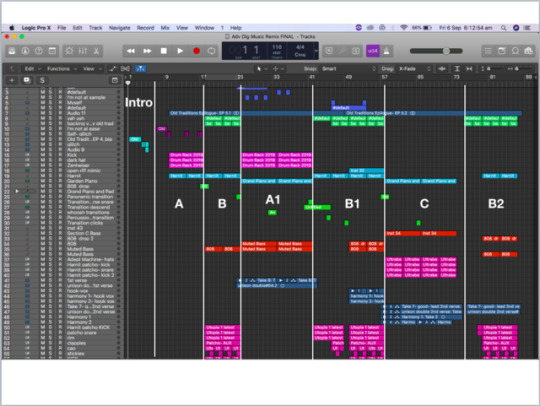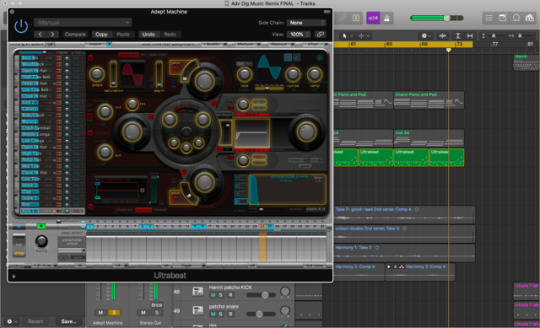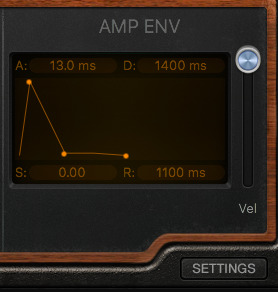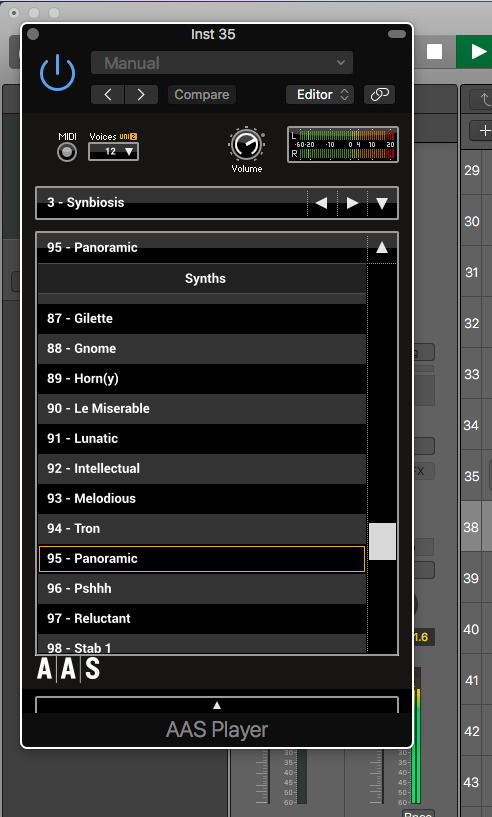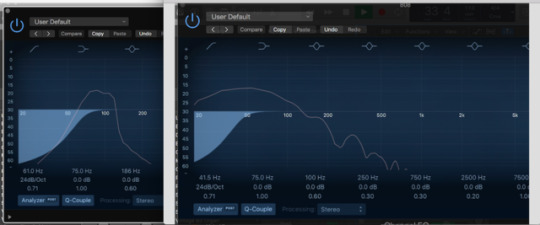Don't wanna be here? Send us removal request.
Text
LINK TO FINAL REMIX
https://soundcloud.com/user-231624278/outrageous-remix-adv-dig-music
0 notes
Text
Session 1: Initial Steps + Rationale
I have chosen to work with an original track I created in the past (attached). Initially I chose a different track but found myself quite lost and was not making a sufficient amount of progress, so I decided to use another track in hopes that it would spark new ideas from different melodies and rhythms present in the track. The first step I took when choosing the track I decided to ultimately use was bounce each individual stem of course. I then loaded the stems in a fresh Logic X session. I first listened back to the vocals (lead and harmonies) and tried to find little melodic fragments and rhythmic ideas, purely based on what I felt was most evocative. I found the melody of the harmonies (audio attached) to be kind of “story-telling” in a way. It is hard to explain but the melody felt “floaty”, so I decided to recalibrate its use and recolour its timbre. I loaded the stem onto an EXS24 sampler on Logic X and focused on finding a note in which the rhythm would work with the track. After doing so, I had to retune the sample down a tone to fit the key. I found that it would also be effective to insert that glitchy layer at the top, which is just the start of the phrase of the sample. Then using the flex tool, I began messing around with the guitar stem, which is originally just me strumming single chords. By experimenting with the flex tool, you can hear in the introduction, the little melody that formed after speeding up the tempo of the guitar chord progression from the original track. After this I began cutting and snipping little melodic fragments from the lead vocal line and repurposed them in the remix. I focused on what provided the most interest in terms of melody and rhythm. Once I got into the track, I began thinking about what I want to create and get out of the track. I decided to take the meaning of the original track and basically kind of subvert the meaning of it, whilst creating an extension of its story. The original track is called “Old Traditions” and it follows the story of an individual being trapped within the boundaries of nostalgia and being so attached to nostalgia because of the fear of never being able to be in the same and safe environment as they were in their past. Basically the idea of a new chapter with new people scares them. I think it would be fulfilling to take the original meaning and kind of subvert it in a way where I would create a track that envelops the idea that this individual found comfort after a tough time adjusting a new stage of their life. The lyric “I see darkness” represents the idea of comfort in a twisted way. Darkness in this case represents rest, sleep, anxiety-free and comfort. Although, I want the track to capture the challenges and exhaustion of the individual. As a result of this I want some sections to feel unsettled, perhaps with unsettled percussion and abrupt transitions into contrasting sections. The overall sonic aesthetic I intend to work towards is experimental RnB/ Pop but keeping elements of minimalism at heart.
0 notes
Audio
0 notes
Text
Session 2: Establishing sections
As mentioned in the rationale, I wanted to create contrasting sections, a section with unsettling rhythmic devices and “organised mess”, the other where that sense of release and comfort is felt. I think a good method to do this would be to create that distinction with percussion. I chose to create the busy beat found in section B (main hooky section as annotated on session). To create a busy percussive section, I created simple individual layers and focused on the interplay of each layer with the others. My process for this was to literally just create a drum rack using my own sounds I have and just piling on different layers with different timbres. To create that tension and release notion between each section, I tried to create very busy layers in section B and more minimalist and settled ideas in section A. In section A, you can hear that rapid cyclical arpeggiated retro synth pattern. I chose to do this, not just for how chaotic it is but I think the cyclical nature can also represent the constant challenge of overcoming something, which is something I outlined in the rationale. I kept the timbre of synth quite clean and generic just so that it is something “easy” for the audience to listen to as there are other unique sounds I want to keep in focus. I experimented placing the cyclical synth pattern in a lower octave but felt that it fulfils the middle register of the song well, also allowing space for the bass and kick to breathe and be present.
0 notes
Audio
0 notes
Text
Session 3: Drums!!!
As one of the parameters was to incorporate step-sequencer or algorithmic composition, I chose to go with step-sequencer as it is something I have previously been keen to experiment with. This was my first time using a step-sequencer, so I used a pretty straight-forward Logic X instrument called “Ultrabeat”, which has an inbuilt step-sequencer (screenshot attached). To be completely honest, I did not really understand what was going on, but I just kept pressing buttons until I found a groove that worked well with the section and my intention and I stuck with it. After selecting the sequence I liked, I dragged the information into a new MIDI track and substituted some of the drum sounds (kick, snare, auxiliary percussion) with my own sounds and left the stock hi-hats as is. I selected this particular groove because I was finally creating the drums for the section of the track that feels at ease and comfortable for the audience, in comparison to the busy rhythmic parts of the other sections (section B). As briefly mentioned above, for the sections where I wrote the rhythm of the complex drum sections, I created my own drum rack using my own sounds and began writing simple rhythms horizontally and just kept layering different percussive elements until I ended up with that busy beat (audio file attached). I used sounds that sit high on the spectrum and offer more woody, clicky, sticky and thin sounds for the auxiliary drum sounds as I felt that it contributes to that “uneasy” feeling mentioned in my rationale. I think these sounds at the frequency that they are at and the overall timbre are sensory inducing sounds, at least that is the effect it has on me as a listener. It feels that the sounds sit quite close to the ears, which is why I think it has that effect.
0 notes
Audio
0 notes
Audio
0 notes
Audio
0 notes
Text
Session 4: Main Melody + Vocals
Writing my main melody and what instrument would carry it is something I really struggled with, however, after discussing this with my lecturer, I was advised to just keep it simple and write my own original melody as opposed to attempting to create one from pre-existing material. I decided that because of the complex nature of what already exists in my remix, with the staccato notes and the choppiness, I needed something to counteract that and ground the song, so I wrote a very minimalist legato vocal melody line. In section C, I wrote an additional vocal melody for more interest and a little more information to give the listeners as to what the track is about. The lyric “It was somewhere/ You kept me/ Under your sheets” connotes to the idea of finding comfort with someone else and as mentioned earlier “At last I see darkness” implies the comfort and stillness found in the idea of nothingness; darkness. As for writing the melody, my process was just playing the chords on a piano and workshopping various melodies that came to mind. If I could change one thing about the vocals, it would be for me to have spent more time on writing the melody but because I was struggling with the issue of what to do with the main melody, I think I wasted a lot of time and should have scratched my first idea earlier. To record the vocals, I used a RODE NT1, which ran through a Focusrite interface and straight into Logic X. I chose this mic, mainly because it is what I have access to at home and was told by a lecturer that is works with my voice type. With the harmonies, I mainly did the same process, I workshopped what sounded best with the melody, chords and cadences and recorded what I felt was most emotionally evocative. When judging what is emotionally evocative, I pretty much just listening back to the harmony and if it gives me a good feeling, I go with it. The only harmony that i wrote differently is the one in section C, where I mimicked the melody of the guitar in the introduction. Initially, I was going to mimic that melody with a synth but it just did not sound right and did not sit well in the track, so I decided to just sing it as an additional harmony (audio snippet attached). I used melisma to replicate the rapid note changes and felt that it was the most effective manner in which I could get closest to the melody.
0 notes
Text
Session 5: Bass
I used a combination of the retro synth bass, 808 bass and an 808 pitch drop for the bass of this track. When the bass enters the track for the first time in section B after the pitch drop, I kept it quite simple, just the arpeggiated chords to help introduce the new section of the song and ease the business a bit. In section A1, I layer the retro synth bass and the 808 bass because I like the punchiness and tightness of the 808 over the looseness and release of the retro synth bass. To help accentuate the “looseness” of the synth bass, I extended the sustain of the notes. With this bass line, I tried to support the vocal line, this is particularly seen on the line “I see darkness” as the bass follows the melodic contour of the vocals. I chose to do this just to follow the same purpose of the vocals, to keep is minimal amidst the busy nature of the rest of the components. For section C, I kept it fairly simple and just had to bass play arpeggiated chords. I did this purely because I kept singing that arpeggio pattern when trying to experiment with bass lines, it just felt the most settled in a section that needed to feel most grounded, so a complex bass line would not have worked.
0 notes
Text
Session 6: Finishing touches
At this point I was mainly focused on creating a bit more fluidity between each section, so I began working on adding last transitional elements between each section. An example of this is at the beginning of the track when the main hook melody comes in and there is an 808 pitch drop. I decided to use the 808 pitch drop as a transitional tool as that rapid pitch drop alludes to the idea of something being released and hence a new action is needed. Although I wanted the disparity between each section, one of the bigger challenges was not only working transitions but also what sounds to use. Should I use sounds that are low or high frequencies, a high shimmer, long reverb, etc. Moving into each section, I tried to keep each transitional sound(s) fresh and not constantly repeating the same thing over and over. For the transitions that were single shot percussive sounds, they were sourced from my own library of sounds I have gathered overtime and for the longer held out sounds, I used a plug-in called “Applied Acoustic Systems”, which has a variety of sounds such as synths, percussion, pads, etc. (screenshot of AAS attached). I wanted to use more shimmery kinds of sounds, so particularly for the single-shot percussive transitional sounds, I used a large reverb tail to create the illusion of space. This can be heard in Section B2 (two ascending woody sounds).
0 notes
